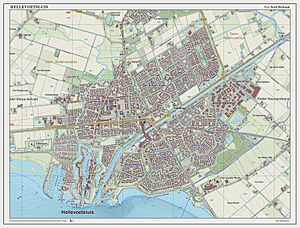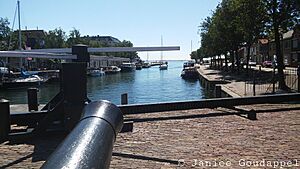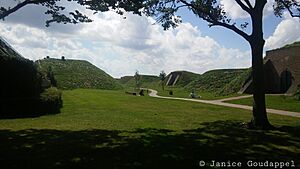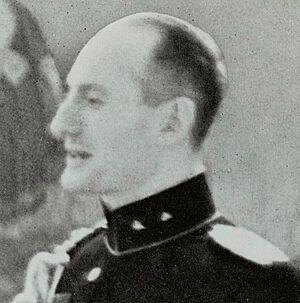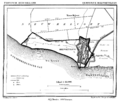Hellevoetsluis facts for kids
Quick facts for kids
Hellevoetsluis
|
|||
|---|---|---|---|
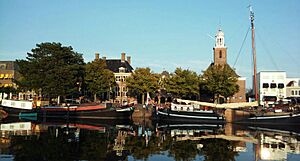 |
|||
|
|||
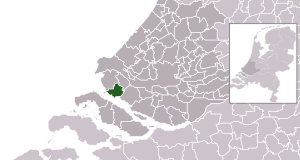
Location in South Holland
|
|||
| Country | Netherlands | ||
| Province | South Holland | ||
| Municipality | Voorne aan Zee | ||
| Area | |||
| • Total | 46.27 km2 (17.86 sq mi) | ||
| • Land | 31.56 km2 (12.19 sq mi) | ||
| • Water | 14.71 km2 (5.68 sq mi) | ||
| Elevation | 2 m (7 ft) | ||
| Population
(May 2014)
|
|||
| • Total | 38,919 | ||
| • Density | 1,233/km2 (3,190/sq mi) | ||
| Demonym(s) | Hellevoeter | ||
| Time zone | UTC+1 (CET) | ||
| • Summer (DST) | UTC+2 (CEST) | ||
| Postcode |
3220–3225
|
||
| Area code | 0181 | ||
Hellevoetsluis is a town in the western Netherlands. It is located in the South Holland province. The name means "lock at the foot of the Helle". The Helle was a small local river that has now disappeared.
Hellevoetsluis is located near the Haringvliet, a large body of water. It is also close to the sea, beaches, and dunes. On January 1, 2023, Hellevoetsluis joined with Brielle and Westvoorne to form a new municipality called Voorne aan Zee.
Contents
History of Hellevoetsluis
The area around Hellevoetsluis has been settled for a very long time. People lived here even before the Romans arrived. The name "Hellevoetsluis" comes from an old river called the "Helle". The word "voet" means "foot" in Dutch, and "sluis" means "lock". So, it was a lock at the foot of the Helle river.
Hellevoetsluis has always been connected to water. During the Eighty Years' War, it became a very important naval port. It was the home base for the Dutch war fleet. The port was built like a fortress, with a special harbor and shipyards. This made it a unique place, combining a strong fort with a busy naval base.
Famous Dutch admirals like Maarten Tromp, Michiel de Ruyter, and Piet Heyn used Hellevoetsluis as their home port. In 1688, William III of Orange sailed from here with his invasion fleet. This event was part of the Glorious Revolution in England.
Growth and Decline
In 1830, the Voorne Canal was built. This canal connected Hellevoetsluis to Rotterdam, making it an important outer port. The town grew and became very prosperous because of shipping.
However, in the early 1900s, Hellevoetsluis started to decline. Ships became too big for the canal. A new, larger waterway called the Nieuwe Waterweg was dug, which made the Voorne Canal less important. The naval base moved to Den Helder in the 1930s.
During World War II, the town suffered a lot. In 1944, about three-quarters of its buildings were destroyed. The Germans also used the canal as a base for small submarines.
Modern Hellevoetsluis
After World War II, Hellevoetsluis grew a lot. Its population doubled in the 1970s. Today, many people live here. Many of them travel to work in nearby Europoort or Rotterdam.
In 1953, a big flood hit the area. After this, the Netherlands built the "Deltawerken." These are huge sea defenses, like dams, to protect the low-lying islands from future floods.
Hellevoetsluis has many old buildings from the 16th to 19th centuries. These include the "Admiraliteitsgebouw" (now the town hall), the "de Hoop" windmill, and Fort/Bastion Haerlem. The "Droogdok Jan Blanken" is a historic shipbuilding site. The Water Tower Hellevoetsluis, built in 1896, is also a famous landmark.
Things to Do in Hellevoetsluis
Hellevoetsluis has many shops. There are small local centers and a large indoor shopping centre called De Struytse Hoeck. This center has over 120 shops.
The town offers schools, a library, and healthcare. It also has modern facilities for water sports. The Haringvliet is perfect for surfing and sailing. There are many places to moor boats. The beach and dunes at Voorne, which are a nature reserve, are also close by.
Water Sports Fun
Hellevoetsluis is one of the biggest water sports centers in the Netherlands. It has 2,000 places for boats to dock, spread across five harbors. The large Haringvliet and the nearby North Sea make it a popular spot for water sports lovers. Many national and international water sports events are held here.
Entertainment and Events
The old town center, inside the fortress, has many outdoor cafes. These cafes look out over the busy harbor. There are also many restaurants and bars serving different kinds of food. You can also find a petting zoo, a sailing school, and a fitness center nearby.
In August, the "Fortress Days" (Vestingdagen) used to be held. This event included live music, a market, ship displays, and fireworks. However, this event is no longer organized.
Every two years, the Dutch Classic Yacht Regatta takes place in the harbor. You can see many beautiful old yachts during this event.
Museums to Explore
The town has well-preserved fortifications in its fortress area. You can take a walking tour to see historical buildings. These include the lighthouse, the Prinsehuis, and the De Hoop windmill.
There are also several museums:
- The Gesigt van 't Dok museum has a model of the town, fortress, and naval shipyard from 1834. It shows how Hellevoetsluis became a modern naval port.
- The National Firefighting Museum shows a large collection of firefighting equipment. You can see everything from old water buckets to modern gear.
- The Oudheidskamer museum displays items from daily life over the last two centuries. It includes things related to Hellevoetsluis's past as a naval port and its farming history.
- The Hellevoetsluis Dry Dock was built in 1806. It was a big step forward in shipbuilding. This dry dock is still working today and is an important historical site.
Hellevoetsluis and Other Towns
Hellevoetsluis is connected to Torbay, England, as a twin town. This is because on November 5, 1688, William III of Orange sailed from Hellevoetsluis. He landed in Torbay with 463 ships and 14,000 men. This journey was part of the Glorious Revolution, where he claimed the thrones of Great Britain.
Famous People from Hellevoetsluis
- Jan Pieter Theodoor Huydecoper (1728–1767): An administrator who worked for the Dutch West India Company.
- Theodoor de Booy (1882–1919): A Dutch-born American archaeologist.
- Jan Greshoff (1888–1971): A Dutch journalist, poet, and literary critic.
- Dirk Klop (1906–1939): A Dutch Army intelligence officer.
- Adriaan Wesselink (1909–1995): A Dutch astronomer who studied variable stars.
- Anthony van Kampen (1911–1991): A Dutch writer.
- Ellemieke Vermolen (born 1976): A Dutch actress, model, and TV presenter.
- Ronald Brouwer (born 1979): A field hockey player who won a silver medal at the 2004 Summer Olympics.
- Maarten Ketting (born 1983): A soccer referee.
- Duncan Laurence (born 1994): A Dutch singer-songwriter who grew up in Hellevoetsluis.
Images for kids
See also
 In Spanish: Hellevoetsluis para niños
In Spanish: Hellevoetsluis para niños



